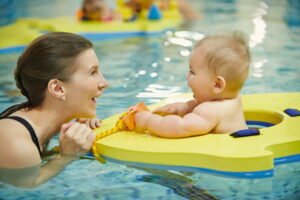Baby swimming is a delightful and beneficial activity that not only introduces babies to the joy of water play but also promotes their physical development and confidence. However, it is essential to prioritize water safety and ensure a secure environment for little ones. In this guide, we explore the advantages of baby swimming, water play activities, and essential water safety tips for a safe and enjoyable experience.

Benefits of Baby Swimming:
- Physical Development:
- Baby swimming supports muscle development and coordination as babies move and kick in the water.
- The buoyancy of water reduces the impact on joints, allowing babies to explore movement freely.
- Cognitive and Sensory Stimulation:
- Babies experience new sensations and stimuli during water play, enhancing cognitive and sensory development.
- Visual and tactile experiences in the water encourage curiosity and exploration.
- Bonding and Social Interaction:
- Baby swimming provides a wonderful opportunity for bonding between parents and their little ones.
- Babies may interact with other babies in a safe and supervised environment, fostering social skills.
- Confidence and Independence:
- Feeling supported in the water helps babies build confidence and independence.
- They learn to trust their caregivers and feel secure in new environments.
Water Play Activities:
- Gentle Splashing:
- Introduce babies to gentle splashing and water movements to acclimate them to the water.
- Use soft and gradual movements to create a soothing experience.
- Floating and Gliding:
- Support babies on their backs, allowing them to experience the sensation of floating.
- Glide babies through the water while maintaining constant eye contact and gentle communication.
- Singing and Water Games:
- Sing nursery rhymes and engage in water games to make the experience enjoyable.
- Use colorful floating toys to entertain and engage babies during water play.
Water Safety Tips:
- Supervision:
- Always provide constant and close supervision during baby swimming sessions.
- Keep within arm’s reach of the baby, especially in deep water.
- Use Floatation Devices:
- Utilize age-appropriate floatation devices, such as swim rings or vests, to support babies in the water.
- Remember that floatation devices are not a substitute for supervision.
- Gradual Introduction:
- Introduce babies to water gradually and ensure they are comfortable and responsive to the environment.
- Avoid any activity that may cause fear or distress in the water.
- Comfortable Water Temperature:
- Maintain a comfortable water temperature between 32°C to 34°C (90°F to 93°F).
- Cold water can be unsettling for babies and may lead to discomfort.
- Choose Safe Swimming Areas:
- Opt for pools or facilities with appropriate safety measures and trained instructors.
- Follow guidelines provided by professional baby swimming programs.
- Regular Checkups:
- Before starting baby swimming classes, ensure that the baby’s health and immunizations are up-to-date.
- Consult with a pediatrician if there are any concerns about water activities.
Baby swimming provides numerous physical, cognitive, and emotional benefits, making it a delightful experience for both babies and parents. By prioritizing water safety and creating a secure environment, caregivers can offer little ones a positive and memorable introduction to water play while nurturing essential life skills and confidence in the water.






